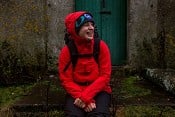In reply to Rich C1:
> (In reply to ryedubs) cheers, much appreciated. That sorts out one of the questions. Anyone else out there got any useful tips - particularly about the % of light transmission.
just thought i better add, % of light transmision is different to UV i think.
say you had dark glasses that filterd out the bright light but had no UV filter, this would actually be bad for your eyes; as you pupils open up because it is dark, therefore letting in more uv because although the lenses are filtering out visible light, they do not filter out UV. if you get my drift. so in reality, glasses that do not filter out UV but are tinted, can cause more UV to enter the eye than wearing none at all.
so really what you want it is, %100 / 400nm uv filtering, and then pick what category of glasses (0,1,2,3,4) you want depending on the activity you shall be doing.
if its for the alps, then most people go with a 3 or a 4. you're better with a 4 for longer durations at high altitude. but then as you descend, or if the whether is overcast, you may not be able to as well with a 4.
you can get photchromatic lenses that change from varying categories too, depedning on the levels of UV. however these too have their floors, as sometimes, the uv is low so they are not so dark, but the light intenstiy is high, or the UV could be high so they are very dark, but the visitbility poor and you cannot see much.
also, one of the most important things to remember is that the glasses should come with side shields to protect from the reflected light getting in and around the edges of your sungigs. and there's no substitue for trying the sungigs on to see if they close around your face propery.
just thought i better add the bit about visible light and UV being different just incase you didn't know.









